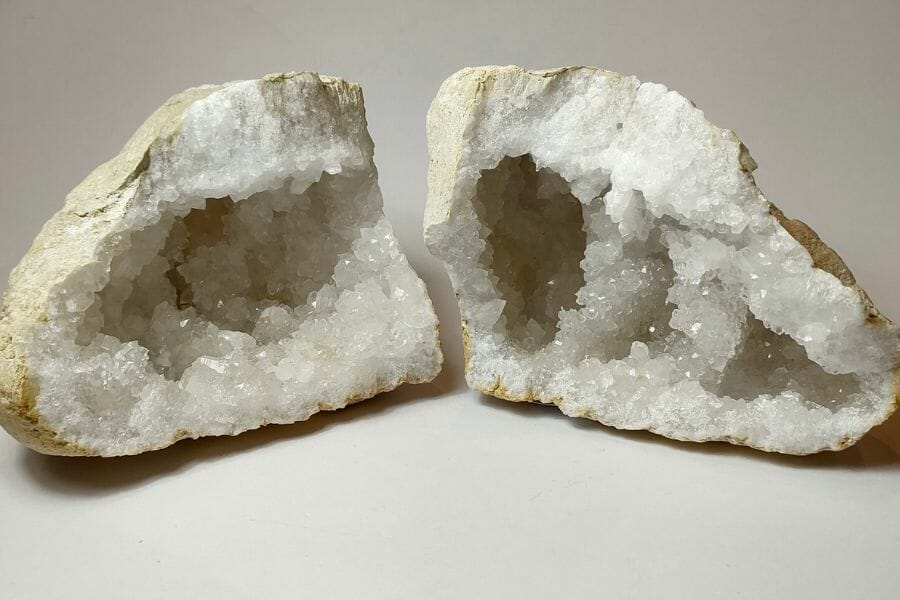Geodes are like nature’s surprise eggs, filled with sparkling crystals inside a plain-looking rock. Our state is a treasure trove for these hidden gems, with its many different landscapes that make it perfect for rock hounds.
If you’re itching to crack open your own crystal-filled wonder, you’re in the right place!
This article will show you the best spots in our state to find geodes. We’ll also share some handy tips to make your geode hunting adventure a success.
So grab your hammer and get ready to discover the beauty hiding in ordinary-looking rocks all around this state!
How Geodes From Here

Geodes form when bubbles in volcanic rocks or spaces in sedimentary rocks get filled with minerals over time.
First, water rich in minerals like quartz or calcite seeps into the hollow space. As the water evaporates, it leaves behind the minerals, which slowly build up layer by layer.
Eventually, these minerals create a crystal lining inside the geode. The outer shell stays rough, while the inside becomes a sparkling treasure.
The process can take thousands, even millions, of years, making each geode a unique and beautiful time capsule of Earth’s natural forces.
The Types Of Geodes Found in the US
There are many fascinating varieties of geodes that can be found across the United States, including in our own state. Each type is distinctly beautiful and intriguing:
Amethyst Geode

Amethyst geodes look plain on the outside, like a potato. But crack them open, and you’ll find stunning purple crystals. These crystals can be light lavender or deep purple.
The structure of crystals inside can vary widely. Some are tiny and densely packed, creating a sparkling surface. Others form large, distinct points that jut inwards.
The color range is impressive too, from pale lilac to deep royal purple. Some amethyst geodes develop unique features. “Stalactites” of amethyst might hang from the top.
In rare cases, you might find a water bubble trapped inside, a remnant from the geode’s formation millions of years ago.
Citrine Geode

Citrine geodes are eye-catching rocks with golden yellow to orange crystals inside. They sparkle when light hits them, looking like sunshine trapped in stone. The colors come from iron mixed in with the quartz.
Unlike many gemstones, citrine’s color is often evenly distributed throughout the crystal.
Most citrine on the market isn’t natural. It’s actually heat-treated amethyst. This process turns the purple amethyst into vibrant citrine. Natural citrine is rarer and often has a more subtle color.
Pyrite Geode

Ever cracked open a rock and found gold inside? Well, not real gold, but something that looks just like it. That’s a pyrite geode. Pyrite is called “fool’s gold” because it’s so shiny and golden.
Inside these geodes, pyrite forms in cool shapes. Sometimes it’s perfect cubes. Other times its clumps or even round balls called “pyrite suns”.
Pyrite has a fun history. People have been mixing it up with real gold for thousands of years. That’s how it got its nickname.
Selenite Geode
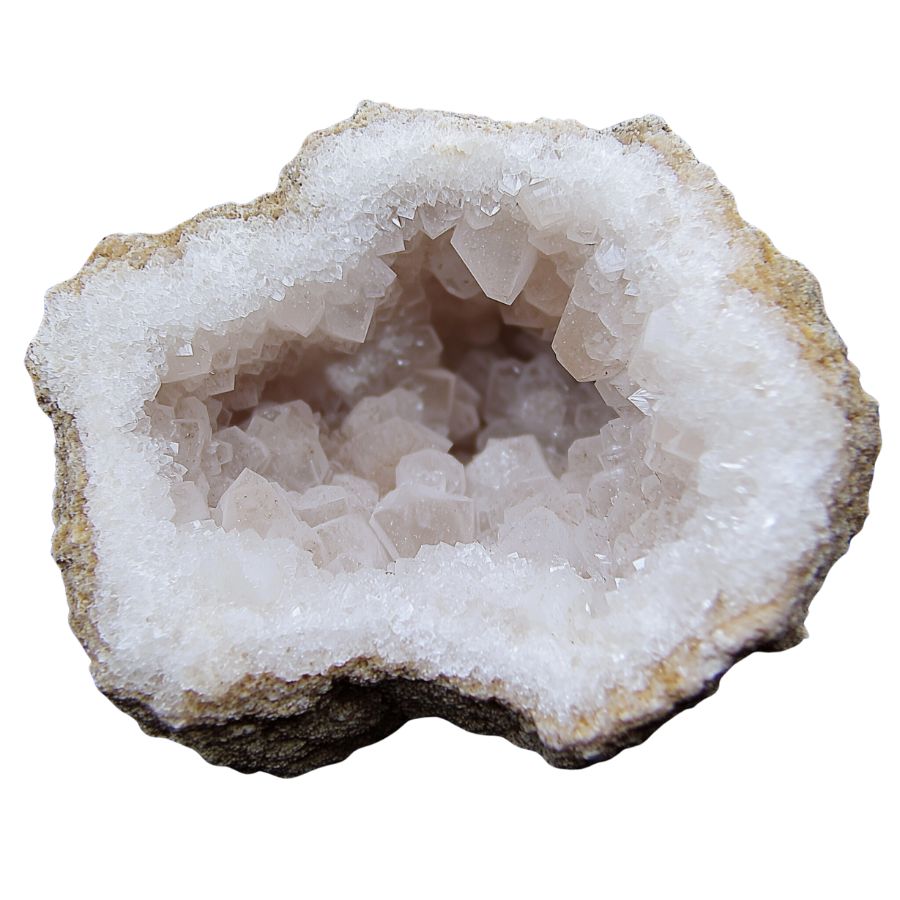
Selenite geodes stand out from the crowd. They’re white and see-through, with a glassy look. When you open one up, you’ll see crystals that look like they’re made of ice or moonlight.
Unlike harder geodes, selenite is soft. You can scratch it with your fingernail! This softness means you need to handle it carefully. But it also means selenite can be shaped into beautiful forms easily.
One cool thing about selenite is how it plays with light. Hold it up to a lamp, and you’ll see the light shine right through it. This makes selenite geodes popular for decorative lamps and light fixtures. They add a magical glow to any room.
Celestite Geode

Celestite geodes are like pieces of sky trapped in rock. Their crystals are typically a delicate blue, ranging from almost colorless to deep sky blue. In rare cases, celestite can form in other colors. Pink celestite is highly prized by collectors.
One unique feature of celestite is its perfect cleavage. This means the crystals can be easily split into rhombohedral shapes.
These geodes form in a unique way. They start as nodules of a soft mineral called alabaster. Over time, this dissolves and is replaced by celestite crystals. Some celestite geodes are huge, like the famous Crystal Cave in Ohio.
Celestite isn’t just pretty to look at. It’s used to make strontium, an element with many uses. You’ll find strontium in fireworks, where it creates red colors. It’s also used in making TV screens and ceramics.
Jasper Geode
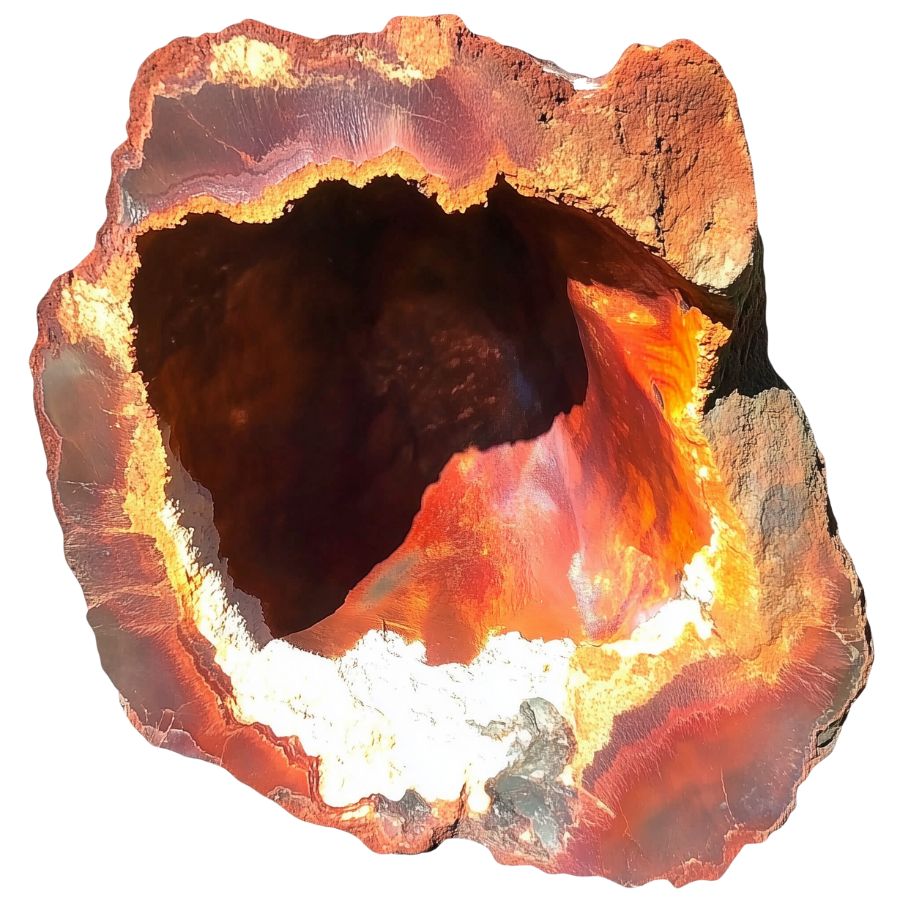
Jasper geodes are the chameleons of the mineral world. They can appear in almost any color, often with multiple hues in a single specimen. Patterns can range from solid colors to intricate swirls, bands, or spots.
One fascinating type is picture jasper. These geodes contain patterns that resemble landscapes, with “skies,” “mountains,” and “rivers” visible in the stone. Each one is like a miniature painting created by nature.
Some jasper geodes contain orbicular patterns – spherical structures that formed as the jasper solidified. These create eye-catching bull’s-eye or flower-like designs in the stone, making each piece truly one-of-a-kind.
Carnelian Geode

Carnelian geodes have vibrant orange to reddish-brown colors. They can be somewhat see-through, which makes them look even more interesting. The bright colors come from the iron in the stone.
These geodes stand out from other similar stones. They’re brighter than sard, which is usually darker and more brownish. And unlike agate, carnelian doesn’t have bands or stripes.
Carnelian has been popular for a long time. Ancient Egyptians and Greeks used it to make special rings. It’s tough enough for everyday jewelry.
Some people heat or dye carnelian to make its color even brighter. This makes it a favorite for both rock collectors and jewelry lovers.
Fluorite Geode

Fluorite geodes are like nature’s rainbow. They come in many colors – purple, green, blue, yellow, and sometimes even clear or black. When you open one up, you might see cube-shaped or eight-sided crystals inside.
What makes fluorite special is that you can often see more than one color in a single stone. This is different from many other geodes. Also, fluorite has a unique way of splitting when it breaks.
A cool fact: fluorite glows blue under ultraviolet light. This was first discovered back in 1852. Because of its many colors and this glowing ability, fluorite is sometimes called the “most colorful mineral in the world.”
Scolecite Geode

Scolecite geodes are like tiny crystal caves. They’re usually white or colorless, but sometimes you might find pink, yellow, or green ones.
What makes them special is the crystals inside. They look like thin needles or delicate hairs, all pointing out from the center.
These geodes are different from others because of their crystal shape. Instead of blocky or chunky crystals, scolecite has these fine, hair-like ones. This gives them a unique, delicate look.
Scolecite has an interesting property – it can hold a lot of water in its structure. This means it can absorb and release water easily. This makes scolecite useful in various ways, not just as a pretty rock to look at.
Apophyllite Geode

Apophyllite geodes are like nature’s disco balls. They often have dark or black crystals inside a hollow rock. These crystals can be see-through or slightly cloudy, with cube-like or flat shapes.
What makes apophyllite geodes stand out is how the crystals form. They grow in round clusters that look like tiny disco balls. This unique formation is rare and makes them special to rock enthusiasts.
Collectors really prize these “disco ball” clusters. They’re not common, which makes them valuable to people who love unusual rocks. The way apophyllite crystals catch and reflect light adds to their appeal, making them fascinating to look at and study.
What Rough Geode Looks Like
Identifying a rough geode might seem tricky, but with a few tips, you can spot one even if you’re not a rock expert. Here’s how you can do it.
Look for a Rounded Shape

A rough geode often has a rounded or egg-like shape. It might not be perfectly round but look for a generally bulbous form.
When you’re out searching, skip the flat, jagged rocks. Geodes usually have smoother exteriors because they’ve been rolling around in rivers or other environments for a long time.
Check for a Dull, Bumpy Surface

The outside of a geode isn’t usually shiny. Instead, it’s dull, bumpy, and a bit rough.
Imagine a potato or a clump of dirt with some bumps and dents. That’s how a geode might look before it’s cracked open.
The outside won’t give away much of what’s inside, so don’t be fooled by its ordinary appearance.
Test the Weight

Pick up the rock. Does it feel lighter than it looks? That’s a good sign!
Geodes are hollow or partially hollow, which makes them lighter than solid rocks of the same size. If it feels unexpectedly light, you might have found something special.
Look for Tiny Crystals or Mineral Patches

Sometimes, you can spot small crystals or mineral deposits on the outside. These could look like tiny sparkles or specks of color.
While the outside of a geode is usually dull, a little peek of what’s inside might show through. Keep an eye out for these hints, especially if you’re in a known geode-rich area.
Tips on Where to Look
Once you get to the places we have listed below there are some things you should keep in mind when you’re searching:
Explore Riverbeds and Streams
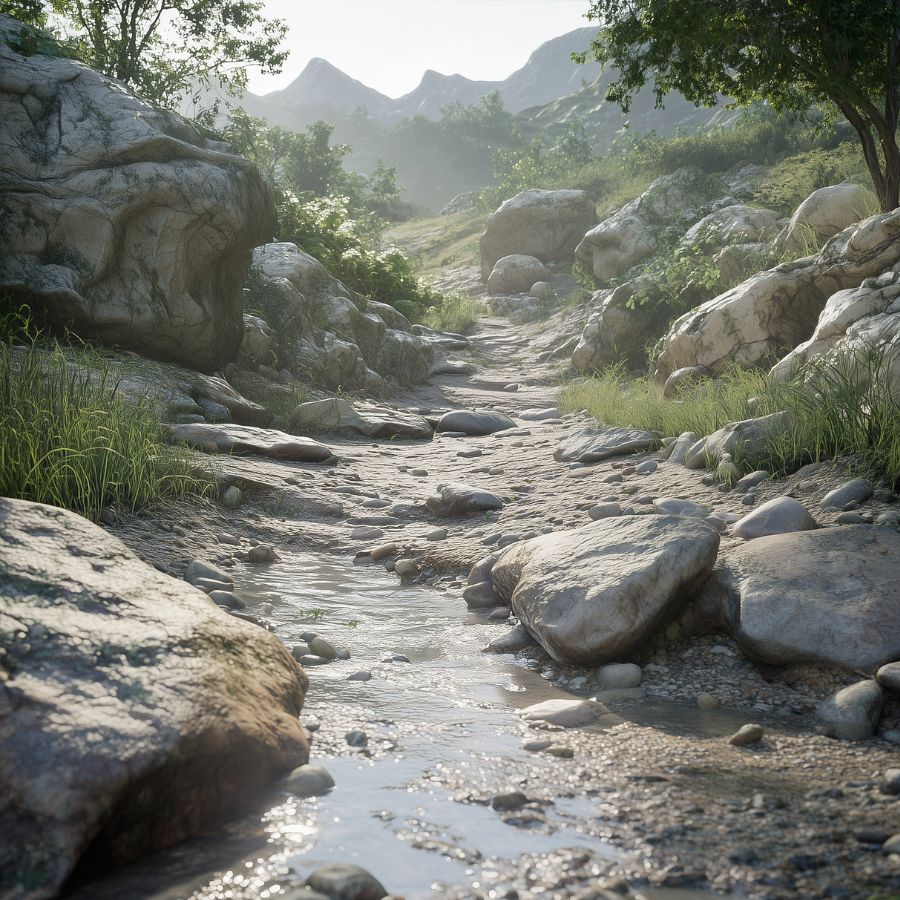
Geodes often form in riverbeds or streams. Water flow smooths out their rough edges and deposits them in these areas.
When exploring, focus on gravel bars or the edges of rivers where rocks naturally gather.
Search in Sedimentary Rock Layers

Sedimentary rocks, like limestone, are prime spots for geodes. These rocks form in layers over time, trapping minerals inside.
Look for areas where sedimentary rocks are exposed, such as cliffs or road cuts.
Visit Old Mines or Quarries

Abandoned mines and quarries are excellent spots for geode hunting.
Workers often missed geodes while digging for other materials. Explore the tailings or leftover rock piles for hidden treasures.
Explore Hills and Rock Outcrops

Hills and rocky outcrops often reveal geodes. As erosion wears away the softer rock, it exposes the harder geodes.
Look for areas with exposed rocks and keep an eye out for rounded shapes.
The Best Places To Find Geodes in New Hampshire

New Hampshire has amazing sites to mine gems, but it has pretty limited locations to search for geodes. In fact, finding naturally occurring geodes here may seem impossible because there is no known spot, as of writing, where you can find them.
But we compiled some of the recommended places in our state where you can find rocks and gems that are just as stunning as geodes. We also included here some locations from nearby states where geodes are naturally found.
Always Confirm Access and Collection Rules!
Before heading out to any of the locations on our list you need to confirm access requirements and collection rules for both public and private locations directly with the location. We haven’t personally verified every location and the access requirements and collection rules often change without notice.
Many of the locations we mention will not allow collecting but are still great places for those who love to find beautiful rocks and minerals in the wild without keeping them. We also can’t guarantee you will find anything in these locations since they are constantly changing.
Always get updated information directly from the source ahead of time to ensure responsible rockhounding. If you want even more current options it’s always a good idea to contact local rock and mineral clubs and groups
Moat Mountain

Moat Mountain is a range in the White Mountains with some of the most scenic views in our state. Just look at its photo! Its terrain is rocky and steep in places, which you will enjoy if you’re into hiking or trekking. There are some pretty challenging sections, but they’re worth it for the views.
There are cool rock formations and glacial erratics surrounding the area. You can also find some neat plant life along the trails, which are well-marked and maintained.
This place is just off Route 16 in North Conway, so it’s a quick drive from most parts of our state. There are also plenty of parking areas along the road. But before you make your trip, make sure to checkout first the most updated collecting guidelines in New Hampshire.
Where we found geode-like formations
You can find beautiful samples of Smoky Quartz and other equally stunning gems if you take the road west to Echo Lake, then take the road west to Camp Albite. You can then park and walk ¾ mile west to dig in Moat Mountain.
DON'T MISS OUT ON ANY GREAT FINDS!
While you're out searching for Geodes you're going to find a lot of other interesting rocks and minerals along the way. The last thing you want to do is toss out something really interesting or valuable. It can be easy to misidentify things without a little guidance.
We've put together a fantastic field guide that makes identifying 140 of the most interesting and valuable rocks and minerals you will find REALLY EASY. It's simple to use, really durable, and will allow you to identify just about any rock and mineral you come across. Make sure you bring it along on your hunt!
Redstone Granite Quarry

Located in the White Mountains region, Redstone Granite Quarry is surrounded by picturesque forests and mountain ranges.
Its terrain is a little rough, but its geology is super interesting. The rock formations here are mostly granitic, and they were formed over millions of years through a process called intrusive igneous activity, which basically means that molten rock pushed its way up through the earth’s crust and then solidified underground. Because of this, the quarry is not only rich in geode-like formations, but is also an amazing site to find New Hampshire crystals.
Getting here is a breeze. You can easily drive up to the entrance and park your car. From there, it’s just a short hike to the quarry itself.
Where we found geode-like formations
If you’re in Redstone Granite Quarry, chances are you are near a beautiful Amethyst sample. There is no particular part of the quarry that you should explore to do that, so make sure you have the energy to search all its nooks and crannies when you get here.
Ruggles Mine
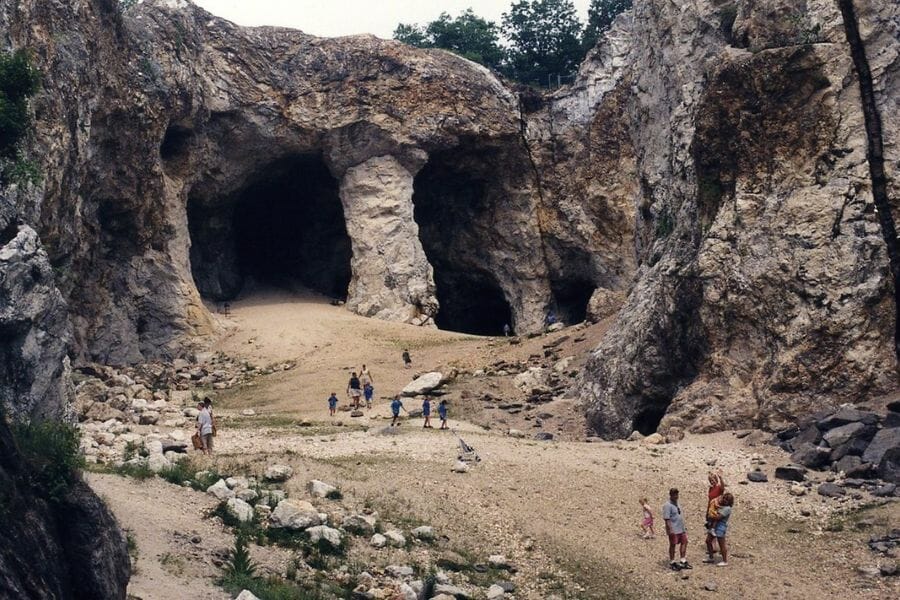
Ruggles Mine’s geography is pretty sweet— it’s located in the central part of our state, in the foothills of the White Mountains. It has some some steep climbs and uneven ground, which only adds to its character.
This mine is massive, with tons of different tunnels and caverns to explore. The rock is mostly mica schist, which is a type of metamorphic rock. That means it’s formed from other rocks getting all mixed up and smooshed together.
This location is right off the highway, with plenty of parking so you won’t have any problem getting here.
Where we found geode-like formations
You can find some of the most amazing samples of Amethyst, Calcite, Quartz (Rose, Smoky, and White), Pyrite and plenty other rocks and gems if you search through the Ruggles Mine in Grafton County.
Cheapside Quarry

A nearby state to New Hampshire, Massachusetts has great sites to find geodes so we made sure to include our recommended locations there, too. One of them is Cheapside Quarry, located in the western part of the state, kinda near the Berkshires.
As can be expected in a quarry, this place has lots of rocks and boulders scattered around. The quarry itself is pretty massive, with lots of different walls to climb. Its rock type is mostly gneiss, a type of metamorphic rock.
Getting here is a bit challenging. You have to hike in a ways from the nearest road, and the trail can get pretty steep in some parts, but it’s worth it once you see those sweet, sweet climbing routes.
Where we found geodes in Cheapside Quarry
To find geodes here, consider exploring the Greenfield region of Cheapside Quarry. Rockhounds have frequently discovered fascinating geodes here, such as the extremely desirable amethyst geodes.
Common New Hampshire Geode-Hunting Questions

We’ll answer some of the frequently asked questions by people wanting to find geodes in New Hampshire in case you’re wondering about them, too.
Where can you find amethyst geodes in New Hampshire?
While you won’t be able to find amethyst geodes naturally here, our state has plenty great spots to find some beautiful amethyst crystals:
- White Mountain Granite Quarry, Hurricane Mountain, Redstone Red Quarry in Carroll County
- Stoddard Mine in Chesire County
- Regional mountain ridges surrounding Berlin, Dummer, Lancaster, Milan, Northumberland and Stratford in Coos County
- All area pegmatite exposures of Milan and Stark in Coos County
- Greens Ledge, Victors Head, Hutchin Mountain, between North Peak and Square Mountain, Percy Peak, and along road of Sugarloaf in Coos County
- Ruggles Mine, Mt. Nancy in Grafton County
- Near the summit of Pillsbury Ridge at the Columbia Gem Mine, Diamond Ledge on Long Mountain, George Hill, and the Globe Mine in Sullivan County
Is it illegal to collect geodes in New Hampshire?
It’s legal to collect geodes in New Hampshire if you following the local collecting laws of our state. Also, make sure you’re aware of and compliant with any additional rules and regulations that are specific to the kind of land that you will explore here.
The Best Places To Buy Geodes In New Hampshire

The surest way to get your hands on geodes here is to visit the local rock and gem shops in New Hampshire that sell them. What’s better is that these stores also offer other natural wonders that are just as stunning (if not even more!) than geodes.
- The Quartz Source Rocks and Minerals – 503 Nashua St, Milford, NH 03055
- Amazon – You’ll be surprised at how great the geode selections are on Amazon. They even have a complete set of kits to help you crack them open.
- Gemstar Gemstone Company – 427 Shaker Blvd, Enfield, NH 03748
- A Broader Concept – 143 Londonderry Turnpike, Hooksett, NH 03106
- Santerre’s Stones ‘n Stuff – 275 Calef Hwy, Epping, NH 03042
- Sunapee Rock Shop – 37 Edgemont Rd, Sunapee, NH 03782
Additional places to find geodes in nearby states
Check out our guides for nearby states if you’ve already tried all of our suggestions above or if you’re planning a trip outside of the state:
If you have any recommendations for our list please leave a comment below!

